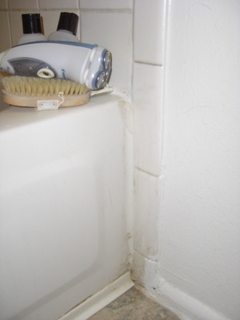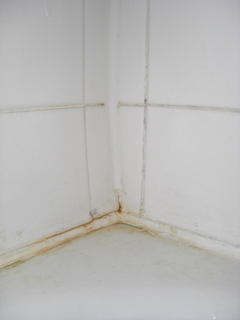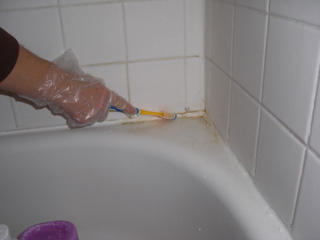No one wants a bathroom full of mold, but before you can get rid of or even prevent bathroom mold, first you have to understand why you have it in the first place and where else bathroom mold might be hiding.
Mold spores are everywhere. It’s not uncommon for you to live with mold for long periods of time without realizing it. Mold is a type of fungi and fungi covers about a fourth of the Earth’s biomass.
What does this mean to you? Well, mold can grow pretty much anywhere and everywhere when conditions are right. Dark moist places like your bathroom are a big target for mold growth.
Mold is Asexual
A single mold spore can asexually reproduce trillions of additional mold spores via mitosis in just days! Not thousands, not millions-but TRILLIONS-that’s like the U.S national deficit worth of mold spores in just one bathroom!
Bathroom Mold Topics We’ll be Discussing:
Do You Have Black Mold?
Bathroom Mold Symptoms and Warning Signs
- Is there a musty or sour smell in your bathroom?
Black mold prospers in small dark rooms that are warm and humid and mold spores often fill the air giving off an unpleasant staleness.
Mold is literally decomposing your bathroom surfaces. Not all mold will be detectable through your sense of smell, however, and you should never sniff mold. Breathing bathroom mold can cause serious health problems, especially in mold sensitive individuals and those with weakened immunity.
- An earthy smell? If your bathroom has an earthy smell, it is probably coming from rotting wood and there is likely to be bathroom mold present.
- Ants in the bathtub? Small ants in your bathroom or tub could be a sign you have hidden mold beneath your tiles or floorboards. Moist environments support mold and other life like ants. Also, carpenter ants, which are larger than termites, also prefer to make their nests in moist wood such as beneath a bathtub or behind a dishwasher.This is bad because they hollow out the wood for nesting. TIP: Using the blunt end of a screwdriver along the bottom of baseboards can help you detect hollow damaged wood.
- A Muddy Appearance? Watch for warning signs like tile with a muddy appearance to it. Muddy looking tiles may in fact be black mold and can be on the walls or on the shower or bathroom floor.
- Watch out for spongy floor boards, from rotting wood, when you step on the tiles.
- Calking that is moldy or cracked.
- Loose tiles. Poor tiling and calking jobs are extremely vulnerable to leaks, which can cause rotting beneath the tile surface. Moisture after a shower often clings to bathtub caulking, causing the substrate to expand making openings in the grout lines.A cracking separated appearance in your caulking is probably a good indication water has been making its way behind the shower walls and mold is probably growing behind the tiles. Many people believe tile and grout joints are sealed and waterproof, but this is often not the case.

What does MOLD look like?
Spotting mold on your bathtub caulking, shower wall tiles or sink is the easy part because it’s ugly and stands out like a sore thumb. However there are many types of mold that can grow in bathrooms and unfortunately, even if you don’t see bathroom mold it doesn’t mean it’s not there.
When you are remodeling your bathrooms, sometimes you are in for an unpleasant shock as you discover bathroom mold that was growing beneath your old wallpaper or under the bathroom carpet. It can also seep through the cracks in your bathtub caulking and grow behind tiles and under the tub.
Dangerous Bathroom Mold
Is Mold Making Me Sick?
While most kinds of mold are not life threatening for healthy people, for people with weakened immunity, including people with asthma, babies and the elderly, a bathroom mold problem can be a waking nightmare. Exposure to black mold can lead to immediate or delayed reactions, so the true cause is not always apparent.
These symptoms may include dizziness, respiratory issues, flu-like symptoms, body aches, skin rashes, seizure, sinusitis, fungal infections of the lungs, depression, irritability, coughing and more.
Thankfully, only around 80 of the 1,500,000 species of fungi are currently known to be allergenic… but for those who are already suffering from allergies that’s more than enough to cause some alarm.
If you or someone in your family is frequently or inexplicably sick, mold is probably a suspect. The most common household fungi include Alternaria, Aspergillus, Basidiospores, Chaetomium, Cladosporium, Penicillium, Periconia and Stachybotrys.
Dangerous Mold are ones that produce Volatile Organic Compounds, or VOCs
VOC’s cause upper respiratory distress by triggering the release of histamines in our immune cells and that can lead to pulmonary diseases like asthma.
What is Toxic Black Mold?
You have to be extremely cautious when it comes to black “toxic” mold, or stachybotrys chartarum, which can even be fatal. These molds create microtoxins, a toxic substance which, when a person is exposed to high quantities can cause serious injuries, especially to children with mold allergies.
For a small price you can usually get a mold testing kit to determine the type of mold you have, or you may want to have a professional, trained in mold removal, to come to your home to run the test for you.
How to Get Rid Of Mold
After identifying the bathroom mold problem, decide which steps are needed for mold recovery. If the contaminated area is confined to a fairly small area that is less than 10 square feet, you may be able to address the mold problem yourself-but if the area is larger or if there is extensive mold damage due to sewer or flood damage, a professional specializing in mold removal should be brought in. Removing mold can be very hazardous without proper Safety Gear and Considerations.
Mold Prevention Tips
- Make an environment unfavorable to mold growth. Mold thrives on moist surfaces- especially dark warm crevices. You can start by simply letting some light into your bathroom by opening the curtains if there’s a window in there. If there is not a window, you can leave a light on now and then-preferably one that is energy efficient or has the full spectrum of light similar to natural sunlight.
- Opening a window to allow fresh air in may also help, however, if you happen to live in a humid climate-such as Florida, it may be wiser to simply turn on the air conditioning and make use of fans.
- Control humidity to prevent bathroom mold.
Keep humidity levels below 60% at all times. 30-50 percent humidity is far better. Some air conditioning units allow you to set your humidity level, otherwise you can buy a Relative Humidity Meter to keep track of your humidity. I’ve seen them online for less than $100.
- Good ventilation is a must. When you take a shower, the steam accumulates on the surfaces throughout the bathroom. A bathroom fan helps draw excess steam out of your bathroom. If you don’t have a fan, and keep the door shut while showering, the steam has nowhere else to go so the condensation will collect around your bathroom on places such as the mirror, ceiling and shower walls. This practically sends an invitation for mold spores to grow.
- After showers, use a squeegee to wipe excess water off your shower walls.
- Towel dry surfaces with excess moisture such as floors, walls, and even the ceiling (Tip: you can put a towel on the end of a broom for better reach)
- Keep fewer products in your bathtub for mold to grow on. Shampoo & conditioner bottles, body wash, razors, shaving gel, bath salts, washcloths, loofah sponges, cups, toys and other items left in and around your bathtub provide convenient crevices for mold spores to grow and hide behind. These items should be limited in a mold prone bathroom, and the ones you do leave in your bathroom should be cleaned with a mold removal product and dried thoroughly.
- Wash bathroom rugs frequently to prevent bathroom mold
- Use a mildew resistant shower curtain or wash shower curtains a couple times/year in the washing machine, or replace it as needed.
- Keep your towels free of mold. A moldy towel will smell sour or stale. You can add vinegar to the wash to help freshen them. Never throw wet towels in a hamper or on the floor. Always hang towels up to dry. If your bathroom is prone to mold, it might help to hang your towels up outside to air dry.
- Clean your bathroom regularly with products that will not endanger your family’s health or the environment
- Beware of Abrasive Products. Abrasive cleansers and scrubbing products can cause bathroom surfaces to wear out more quickly which also makes the bathroom more susceptible to mold growth.
Moldy caulking or sealant in your shower?
 Strip away calking and sealant that has come loose or been infected with mold.
Strip away calking and sealant that has come loose or been infected with mold.
Clean the surface thoroughly and then put new sealant on. You do not want to delay because water will seep through the caulking and then you will have mold beneath the tiles and behind your shower walls. If there is already mold behind your tiles, the new calking will probably soon begin to crack again. At some point you’ll want to remove the bad surfaces, or let a professional do it.
Time to Renovate Your Bathroom?
The next time you find yourself renovating your bathroom, you can help avoid bathroom mold pitfalls by installing a fiberglass shower pan which is more effective against mold and less expensive than a tile one.
Also, avoid using sheet rock or green back as backing for tile in wet or damp environments like a bathroom. Instead, to help prevent mold and rot beneath tile, a better option is to use concrete board or something called the Schluter System. The Schluter-Shower System creates a waterproof barrier beneath the tiles at the top of the system rather than beneath it as some other waterproofing systems do, so it is more mold resistant.
* Mold retardant paint.
Mold retardant bathroom paint may help ward off mold for a few years
* Is it time to upgrade your shower?
Replace your tile shower wall with a one piece shower unit, a smooth surface that mold will not adhere to, without all the leaks and cracks for mold to grow in.
* Mold beneath carpet?
If you have carpeting in your bathroom, you should replace it with an easy to clean surface instead such as tile or linoleum.
Mold Volatile Organic Compounds versus Biocides
While an estimated 10% of the population are sensitive to fungi we still know surprisingly little about our health as it pertains to the world of fungi. But considering fungi covers approximately 25% of the Earth’s biomass, an environmentally friendly approach to mold control is vital for the long term health of our families and the planet.
I do not recommend products with bleach or ammonia for mold removal. Bleach is strong stuff-it is a biocide. A biocide is a chemical that has the capacity to kill all forms of life. Bleach can cause severe skin and eye irritation. Never breathe the vapors. Never mix bleach with other chemicals (that includes vinegar, ammonia, acids, detergents, etc).
The bottle even warns not to mix bleach with organic matter because it will release chlorine gas-and dead organic matter is just what mold in the bathroom and elsewhere like to feed on. Chlorine gas can be fatal and is also irritating to eyes, lungs, and mucous membranes.
Ammonia can be irritating to eyes as well as the respiratory system. Be sure the products you use to kill mold are not making you sicker! Choose environmentally friendly mold removal options instead.
Can Dead Mold Make You Sick?
The other reason I do not recommend using bleach or ammonia to kill mold is because just killing mold may not even solve your problem! I know it seems unfair, but yes, dead bathroom mold can still make you sick! For true mold prevention, it is necessary to understand why mold is in your bathroom to begin with in order to prevent new spores from growing.
Remember, spores are teeny tiny little things and with literally thousands if not trillions floating around, your efforts will be best spent in preventing new mold spore growth rather than simply killing and re-killing the bathroom mold you can see.
The EPA on the Dangers of Mold
The United States Environmental Protection Agency warns that the longer mold grows the more damage and health effects it can cause. Please don’t wait, if you think you have a mold problem, the time to act is now.
Disclaimer: Writestudio.com does not warrant the accuracy or completeness of information provided on this site or that of it’s affiliates, although we do our best to provide accurate information, it may contain errors or be incomplete and is being provided “as is” and is for research purposes only. We cannot and will not assume any liability for it’s use. User assumes all risk. The use of this information indemnifies us from all claims. Should you have any health related questions or concerns about bathroom mold please contact your physician or health care provider.
 The Advantage of using a 3rd Party Mold Remediation Service
The Advantage of using a 3rd Party Mold Remediation Service






 Strip away calking and sealant that has come loose or been infected with mold.
Strip away calking and sealant that has come loose or been infected with mold.